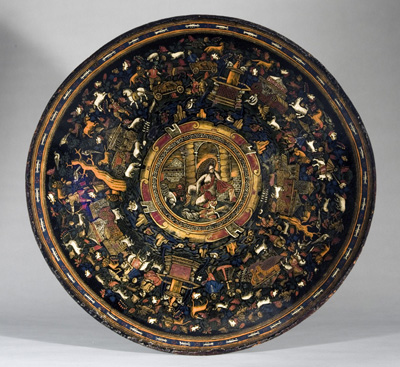Batea
1600-1700
Peribán (Mexico)
Mexican lacquer on wood
H. 8 cm, diam. 56.5 cm
The pre-Conquest practice of applying burnished layers of oil or fat, lime and indigenous pigments onto gourds or wood to produce durable utilitarian wares fascinated early Spanish settlers in Mexico. The technique came to be called Mexican lacquerware, laca mexicana, after the more commonly known lacquenvare of Asia. Colonial documents reveal that the first objects in this medium come from Peribán (Michoacán) as early as the seventeenth century where workshops produced chests, sewing boxes, trays, gourd cups, and bateas, large deep circular trays such as the one illustrated.
In its collection of decorative arts from New Spain, the Hispanic Society has a small but highly significant section of laca mexicana. From Peribán come two exquisite bateas which alone are notable since so few survive. The Society also owns a cabinet signed by the eighteenth-century master from Patzcuaro, Manuel de la Cerda. The batea illustrated here is decorated on both sides with images taken from various print sources. In the center, a woman, probably Diana (but perhaps Cybele) sits surrounded by pastoral and hunting scenes along with creatures ranging from fanciful dragons, armadillos, and unusual large skeletons to more mundane creatures such as horses, dogs, and butterflies.
Text and images © Hispanic Society of America.
